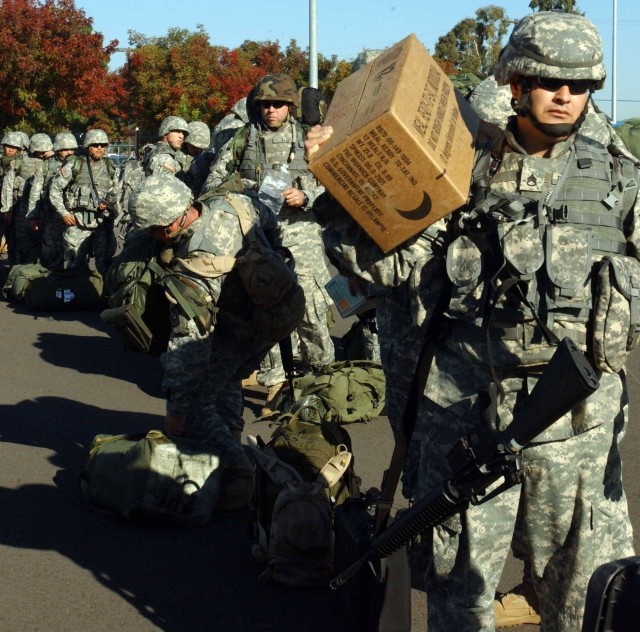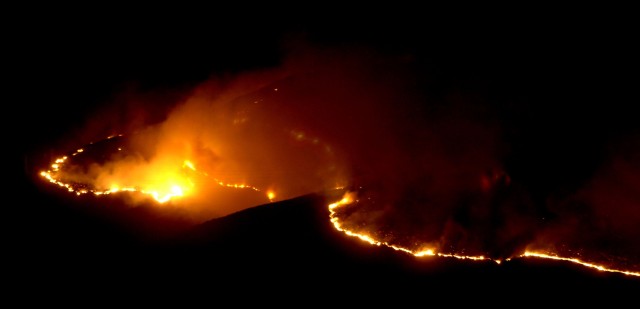SAN DIEGO (Army News Service, Nov. 25, 2007)- Army National Guard helicopters were attacking southern California's ferocious wildfires Tuesday as Soldiers on the ground were manning traffic control points and were prepared to provide people who had lost their homes with some of the necessities of life.
The U.S. Army Corps of Engineers was also preparing for relief missions to communities affected by the spate of wildfires across Southern California. The Corps prepared for missions such as ice and water delivery, and installing generators to provide temporary power at critical public facilities.
National Guard helicopters carrying big Bambi water buckets were trying to bring under control the firestorm that has forced some 500,000 residents to flee the devastated, seven-county region since last weekend.
"This is true and pure homeland defense. This is my home. I live here. This is what I joined to do," said California Army Guard 1st Lt. Robi Yucas, who was coordinating the Guard's aviation assets even as his wife and daughter and dog were preparing to evacuate their fire-threatened home in Oceanside, Calif.
1st Lt.Yucas, from the 1st Battalion, 140th Aviation, was part of the crew that was diverted from the Operation Jump Start mission along the California-Mexican border to support civilian authorities.
Four UH-60 Blackhawk helicopters were dispatched from the border duty to the firefighting mission in support of the California Department of Forestry, and two more Blackhawks and two larger CH-47 Chinooks were expected to fly in Tuesday.
The aircraft attacking the flames was the most visible of the firefighting mission, and the Guard helicopters were expected to fly water-drop missions all day.
A California Guard S-70 Firehawk, specially designed for firefighting missions, was also expected to join the battle against the inferno of a dozen fires that, by Tuesday, had scorched 600 square miles and destroyed a reported 1,800 homes.
It prompted the largest evacuation in California history, from north of Los Angeles south to San Diego, the Associated Press reported.
Meanwhile, 1,500 Soldiers from the California Guard's 40th Infantry Brigade Combat Team conducted presence patrols to prevent looting, manning traffic control points and preparing to assist people at the Qualcomm Stadium and the Del Mar Fairgrounds in San Diego. The Guard Soldiers were supporting the San Diego County sheriff's department.
"(This has) been probably the most proactive response to a domestic event that I have seen in my 40 years in uniform," said Lt. Gen. H Steven Blum, the chief of the National Guard Bureau. "And we continue to be flexible and agile to meet the needs of Governor Schwarzenegger and the citizens of California as they're ravaged by what is a very dangerous and unpredictable fire."
California Gov. Arnold Schwarzenegger on Monday directed that the 1,500 Guard troops be made available for the firefighting mission.
About 70 Guard Soldiers were on duty at the stadium where large stockpiles of water, food and clothing were ready for the displaced people who needed them.
Some of the Guard Soldiers were pulled off border duty to help with the firefighting mission and for their own safety from the fires.
The Air National Guard was expected to reinforce the fight from the air with four C-130 Military Airborne Fire Fighting Systems from North Carolina and Wyoming. The planes that drop large amounts of fire retardant were set to be staged at the Navy's Point Mague facility.
"Disaster responses are a team effort," said Beau Hannah, Emergency Support Function #3 team leader for the Army Corps of Engineers. "The Corps, along with city, county state, and federal agencies will work together as part of a team coordinated by the Department of Homeland Security and the Federal Emergency Management Agency. We know how important it is to affected individuals, families and communities that we provide a fast, competent and complete response to this crisis."
In the Los Angeles District, the Emergency Operations Center is now active and will be staffed continuously until the need passes. The Rapid Response Vehicle team has been dispatched to the vehicle's station and is standing by for its mission. Other Corps teams are en route and will be in place ready to assist Californians.
"We have team members in the community and we're prepared to do more," said Col. Thomas H. Magness IV, Los Angeles District commander for the Corps. "When you see the Corps' castle insignia on a truck or on a helmet, you are seeing the federal response. Most of the Corps team members you see on disaster relief missions have volunteered for that duty."
The Corps, as part of the federal disaster response team coordinated by FEMA, has a number of missions, including temporary housing, water and ice delivery, infrastructure assessment support, debris management and removal and other engineering and logistical missions that are needed.
(Staff Sgt. Jim Greenhill serves with the National Guard Bureau. A news release from the U.S. Army Corps of Engineers also contributed to this article.)
See related article Santa Ana Winds Subside; Officials Expect to Make Fire Progress




Social Sharing